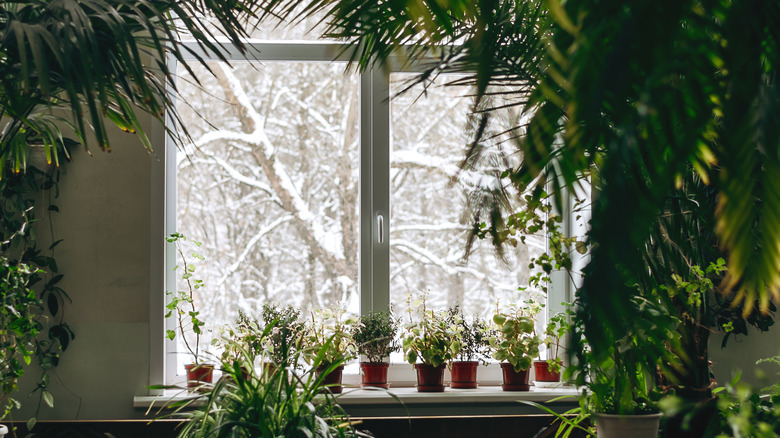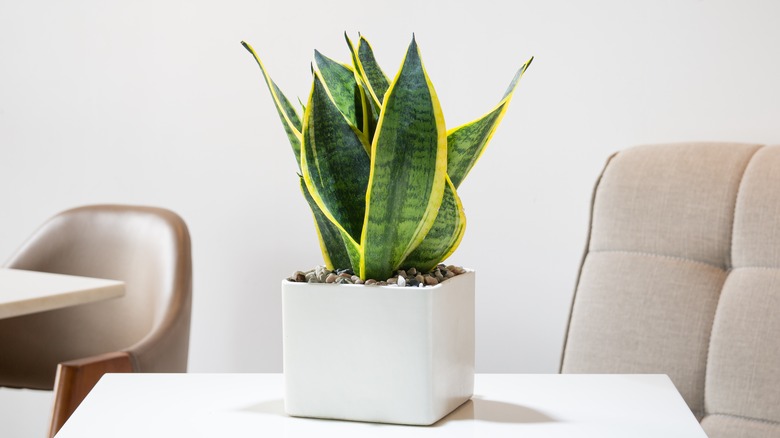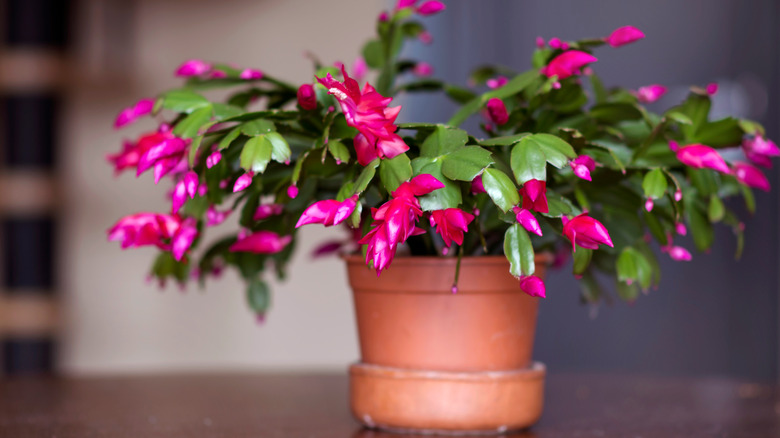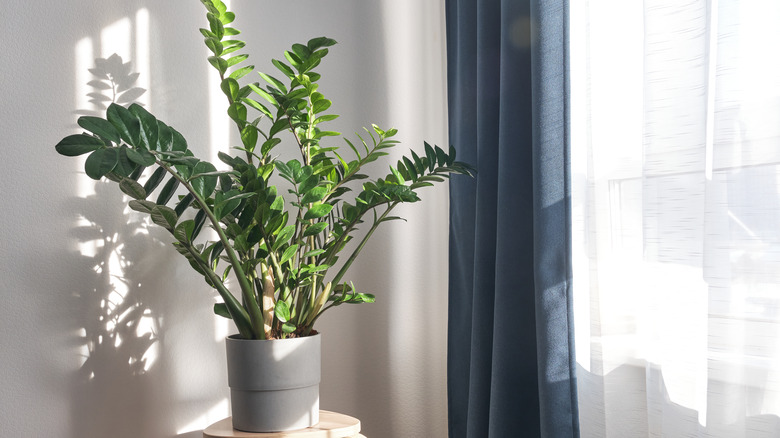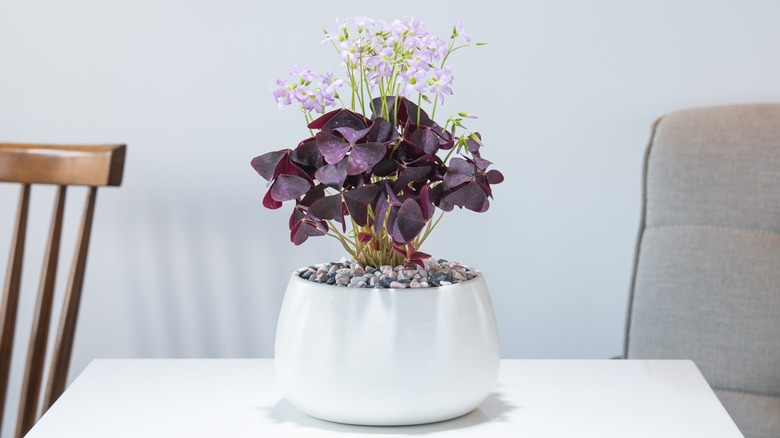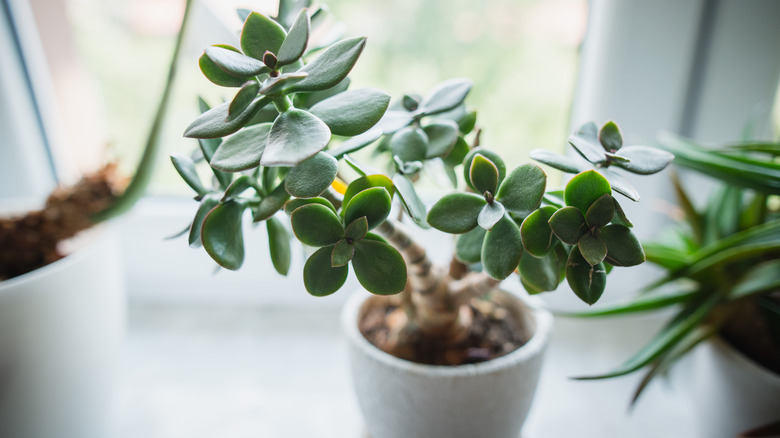5 Plants To Bring Some Color To Your Indoor Space This Winter
Houseplants add warmth and color to any room in your home. During the cold winter months, having houseplants to care for and admire can surround you with a bit of the outdoors when you're stuck inside. Contrary to popular beliefs, taking care of plants in the winter doesn't have to be so difficult. Once you set them up for success, they're less work to care for than in the summer. You won't have to water them as often or fertilize them since they're usually dormant for these months, according to Joy Us Garden.
You must watch out for any drafts, though, when creating an environment for your plants to live in through the winter. Placing them near windows makes sense to provide them with the proper amount of sunlight, but this is often where cold drafts sneak into your home. Instead, move your houseplants back from the window, and use grow lights for supplemental light. Air vents are another place to watch out. When you have your heat on, it'll dry out the air and your plants. To remedy this, consider using a humidifier. Your plants may not thrive during these months, but certain types are resilient enough to make it to spring.
1. Snake plant
Snake plants are perfect for inexperienced owners because they're so sturdy. It's hard to kill this plant, so they can easily survive in winter and add color to your indoor space. Unless you're trying to kill your snake plant and leave it outside in the snow, you can neglect it, and it'll still live. This plant has tall pointed leaves with a green print similar to snakeskin. Their unique look makes them the perfect addition to your collection to incorporate various leaf colors and textures.
All you really have to worry about with a snake plant is that you water them at least once a month. They prefer indirect light but will live with low light and can handle cold temperatures. According to The Healthy Houseplant, snake plants can take being in weather as cold as 55 degrees Fahrenheit; although, this won't be a problem if you keep it indoors. They also don't need a humid environment, so they're perfect if you don't want to purchase a humidifier.
2. Christmas cactus
The Christmas cactus may seem like any other cactus, but during the cold holiday season, it can bloom beautiful flowers in a variety of colors. They come in red, pink, yellow, orange, purple, and white. It's unusual for flowers to bloom during the winter, but with the proper care, this plant will add bright colors to inside your home when the snow covers everything outdoors.
The Old Farmer's Almanac explains that a Christmas cactus needs bright, indirect light to thrive and bloom. This amount of sunlight can be tricky in the winter but grow lights can help. Unlike other cacti, this one needs a humid environment. If you don't want to use a humidifier, placing your plant in the bathroom will also provide it with humidity from when you shower. The Christmas cactus can live with temperatures of 65 degrees Fahrenheit as long as the air is humid. They should be watered about every other week and fertilized monthly to encourage them to bloom.
3. ZZ plant
ZZ plants are unique because of their tall stems and shiny leaves that look similar to feathers. They also have rhizomes under the soil that hold lots of moisture, so they can withstand long periods without getting water. Every three weeks is the most you should water a ZZ plant, according to Simplify Plants. They're great plants to keep in the winter because they can easily adapt to almost any environment.
The biggest tip to keep in mind with ZZ plants is not to shock them with sudden changes. Cold drafts will cause the plant to stress, making their leaves drop, but they can handle temperatures as low as 45 degrees Fahrenheit. However, they prefer 60 F to 70 F. It's the same situation for the amount of sunlight they can tolerate. ZZ plants will thrive and grow rapidly in bright light. Although they will live in low light, just don't expect new growth.
4. Shamrock plant
Oxalis triangularis, also known as the shamrock plant, is another low-maintenance plant that's great to have in your home during winter. It has unique leaves, resembling shamrocks, that can be green or dark purple and will add unique color to your indoor space. Although, what makes this plant really special is that its leaves stay open in the daytime and fold closed every night. It even has white or pink flowers that bloom from spring to summer.
The shamrock plant can take temperatures as low as 60 degrees Fahrenheit but prefers up to 75 F (via Stauffers of Kissel Hill). It usually needs water two times a month maximum and bright, indirect light. However, once dormant during winter, it requires almost no upkeep. Country Living recommends putting your shamrock plant in a cold, dark room for this period. Be sure not to water it either. You'll know your plant is dormant if it isn't putting out new growth.
5. Jade plant
Jade plants may be succulents, but they don't require the same desert environment to live. They're easy to care for because you don't have to water them often. One of the downsides to keeping a jade plant during the winter is that it may become leggy and drop some leaves. However, these green leaves will be perfect for propagating; you don't even have to move them from the spot they fell in (via Houseplant Central).
This plant will thrive in bright, indirect light, which is possible in the winter if you use grow bulbs for supplemental sun. However, jade plants can live in low light, according to Simplify Plants. The same goes for the temperatures they can withstand. Though the plant prefers temperatures between 65 degrees Fahrenheit and 85 F, it can handle 50 F. A jade plant doesn't need frequent watering either since it's part of the succulent family and stores water in its leaves. The most you should water a jade plant is every three weeks.
